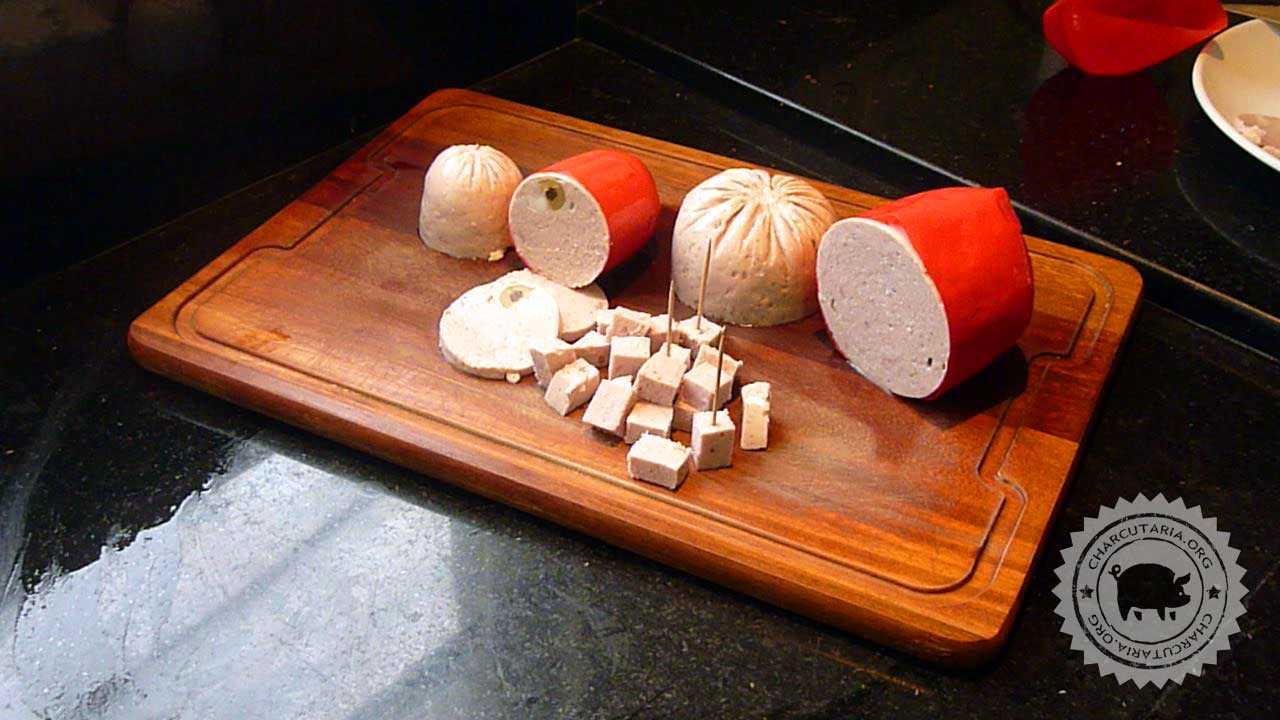
A verdadeira Mortadela(Mortadella Bologna IGP) surgiu no norte da Itália, em Bologna, capital da Emilia-Romagna e é produzida apenas com carne de porco de boa procedência, não são usadas aparas, soja ou miúdos, só carne suína. Desde 2001 a verdadeira Mortadella Bologna é um produto de origem controlada pela União Européia e só pode ser produzida através das especificações do consórcio de produtores da região. Os primeiros registros da Mortadella Bologna são muito antigos e datam de 1661.

No Brasil a Mortadela é quase sempre produzida com uma mistura de carne bovina e suína na proporção de meio a meio. Considero a Mortadela Bologna Ceratti como o melhor produto nacional produzido em larga escala pois é a única que encontrei que não acrescenta carne mecanicamente separada, amido, fécula e/ou proteína isolada de soja. É um excelente produto, mas, por conter carne bovina, não segue a receita Bologna original.
Como é feita a mortadela?
Mortadela é um tipo de salsicha ou emulsão carnea lisa e macia, bastante condimentada e geralmente com sabor picante acentuado pela inclusão agressiva de pimenta do reino, pimenta branca e pimenta jamaica. Tradicionalmente tem calibre bastante alto pois era embutida em bexiga bovina, mas atualmente é mais utilizada a tripa artificial fibrosa não comestível pois é um produto cozido que tem seu invólucro removido após o preparo, sendo assim não precisa de uma tripa natural com custo elevado. No Brasil é quase sempre fatiada bem fininha para rechear lanches, mas na Itália e outros paises é muito consumida cortada em cubos e servida em saladas e aperitivos. Possui pedaços de gordura aparentes e pode conter também pistaches e azeitonas inteiras ou em pedaços grandes. Visualmente é um produto muito bonito, chamativo.
Essa receita foi meu primeiro teste com uma mortadela artesanal. Muita coisa deu errado e ao final explicarei as dificuldades encontradas durante o processo.
Ingredientes da Mortadela Bologna
- 1800 gramas de paleta ou pernil suino desossado
- 350 gramas de gordura suina rígida
- 400 g de gelo moído
- 100 ml de vinho tinto
- 10 gramas de alho picado
- 48 gramas de sal
- 6 gramas de sal de cura 1 (6,25% de nitrito e 93,75% de sal)
- 6 gramas pimenta do reino em pó
- 2 gramas de noz moscada
- 4 gramas semente de coentro torradas
- 1 grama de louro em pó
- 100 gramas de leite em pó
- 150 gramas de gordura suina cortada em cubos, fervida(branqueada) em água por 1 minuto e refrigerada.
- 50 gramas de azeitonas sem semente
- Fundo bovino, bexiga bovina ou outro invólucro artifical entre 80mm e 120mm
Referências
1800g de Pernil = 64%
350g de Gordura incorporada = 12.5%
150g de Gordura em cubos = 5.5%
500g de Gelo e vinho =18%
Peso total da massa 2800g = 100%
48g de sal = 1.7%
6g de sal de cura = 0.21%
100g de leite em pó = 3.5%
Preparo da Mortadela Bologna
1) Remova a pele e separe a gordura. Parte da gordura será usada na emulsão e a outra parte corte em cubos para acrescentar ao final. Caso precise adquira uma peça de barriga ou papada suina e use como fonte de gordura adicional.
2) Limpe, separe a gordura, remova o couro, corte a carne em cubos e misture bem com o sal e o sal de cura. Deixe na geladeira por 48 horas para a ação da cura.
3) Moa separadamente a carne e a gordura que será incorporada usando o disco pequeno e refrigere novamente. Deixe um pouco no freezer para que fique quase no ponto de congelamento. Isso ajuda a manter a massa gelada por mais tempo enquanto processa.
4) Coloque a carne e todos os temperos, exceto o leite em pó, no processador de alimentos e processe por cerca de 5 minutos ou até a massa atingir 5ºC. Adicione o gelo moído periodicamente para manter gelado. Adicione a gordura picada(a ser incorporada na massa) e continue processando até que a massa chegue em 8ºC. Acrescente o leite em pó e processe até que a massa atinja os 14ºC.
No vídeo abaixo há uma demonstração da extração da gordura da carne e couro e o início do processamento.
Fotos da emulsão cárnea.
5) Transfira a massa para um recipiente bem gelado e misture a gordura em cubos branqueada e as azeitonas.
6) Embuta em fundo bovino, bexiga bovina ou outro invólucro artifical entre 80mm e 120mm. Amarre bem firme as pontas pois o cozimento irá estufar a massa. No caso utilizei tripa fibrosa bem resistente de dois calibres, de 60mm e 90mm.
7) Cozinhe a mortadela em água quente a 75ºC até que a temperatura interna atinja 65ºC. Aproximadamente uma hora.
8) Retire da cocção e resfrie imediatamente em banho de água fria.
Considerações finais
O que deu certo
– O gosto ficou bom! Só isso!
O que deu errado
– A quantidade elevada de massa obrigou o processamento em duas etapas e isso acarretou dois problemas, o primeiro foi a dificuldade em separar a gordura, líquidos e condimentos que já estavam previamente pesados e o segundo é que dobrou o tempo de execução aquecendo excessivamente o processador, obrigando-me a acrescentar mais gelo do que o planejado. Em algum momento, que pode ter sido pela baixa quantidade de gordura, aquecimento excessivo, separação equivocada dos ingredientes para as duas etapas ou pela falta de processamento, não sei ao certo qual, quebrei a emulsão resultando em uma textura um pouco quebradiça, granulada. Isso impossibilitou o fatiamento fino, mas, apesar da textura, a mortadela ficou muito saborosa ao consumir em cubos.
– A coloração ficou fraca, o sal de cura não foi suficiente para garantir o avermelhado, vou testar com o corante carmin na próxima tentativa.
– Uma das mortadelas estourou durante o cozimento. Se algum corajoso for se aventurar, prenda com bastante força. Se possível amarre envolvendo toda a mortadela.
– Bolhas de ar. Esse problema creio que seja difícil de resolver com equipamentos caseiros pois é muito complicado embutir algo com calibre tão elevado sem uma embutideira à vácuo. Quem quiser investir em uma planta de produção moderna pode testar essa embutideira especial para Mortadela.
– A quantidade de azeitonas e gordura em cubos foi pequena, quase não apareceu, vou aumentar bastante.
Conclusão
Vou repetir o experimento com proporcionalmente mais gordura incorporada e em cubos. Farei com uma quantidade reduzida de massa, controlando assim melhor o processo.
Fontes: mortadellabologna.com, en.wikipedia.org/wiki/Mortadella, Charcuterie – The Craft of Salting, Smoking and Curing






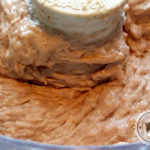
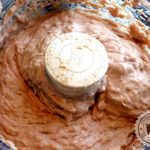
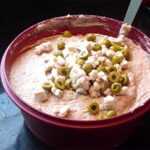
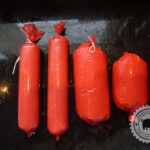
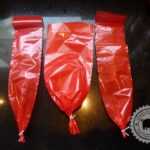

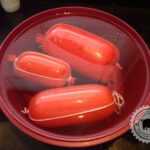
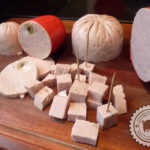
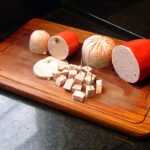
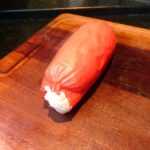

Olá, muito útil o seu experimento!
Tentarei fazer!
Uma informação, para nossa alegria temos hoje no Brasil a MORTADELA ITALIANA produzida pela marca marba, feita apenas c9m carne e gordura suína!
Vale a pena!
Felicidades e muito sucesso,
Boa tarde. Gostaria de obter uma ajuda. Sou novo no processo de confecção de salames e ao fazer o meu primeiro salame adicionei ao processo 6 g de sal de cura, para 1 kg de carne. Acho que me excedi. O salame está em processo de maturação e ainda não provei. Gostaria de saber se haverá algum risco co esse excesso de sal de cura? Obrigado . Lisardo
Oi Lisardo, qual a formulação desse sal de cura? Quantos % de nitrito e nitrato ele tem? Há princípio não há risco caso o sal de cura esteja dentro dos padrões.
Oi. Obrigado por responder. Eu comprei como sal de cura 2.
Vou ver a embalagem para ver se tem mais alguma especificação.
Olá. Eu de novo. O sal de cura é fabricado pela Deremus e diz aqui o nome do produto é Kura k007. O rótulo está meio apagado mas dá prá ler que contém conservadores nitrito de sódio (INS250) e nitrato de sódio (INS…) O número que acompanha o nitrato não dá prá ler. Ok. Obrigado.
O padrão é alto em torno de 6% de nitrito e 1% de nitrato de sódio. Se estiver neste padrão então não há risco ao usar 6g.
Ok. Muito obrigado..